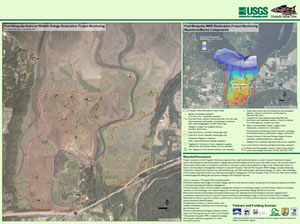Monitoring Design
Nisqually estuary restoration monitoring plan poster (Ellings et al. 2011). Click to enlarge.
We take a very applied and practical approach to monitoring. We start by asking the agency or organization we are working with:
What questions you would like to answer?
What are the management actions you are considering?
What management decisions do you need to make?
From these questions we evaluate site conditions, uncertainties, available resources, and current technologies to determine the best method for addressing each question. We include both biotic and abiotic surveys that allow us to evaluate changes in ecosystem processes in regards to restoration actions and/or larger landscape and climatic changes. The steps we take are very similar to those presented in The Guidance for Habitat Restoration Monitoring (NAVFAC et al. 2004):
Six Steps to Restoration Monitoring
Identify Restoration Monitoring Objectives
Develop Monitoring Plan Hypotheses
Formulate Monitoring Decision Rules
Design the Monitoring Plan Collect Data and Characterize Results
Management Decision
To complete "Step 4. Design the Monitoring Plan" we take the following into consideration. Please click on each topic for more information adapted from The Nature Conservancy: Port Susan Bay estuary restoration monitoring plan (Woo et al. 2011):
There is a wide breadth of information available to guide the design of a tidal marsh restoration monitoring program. Some examples include:
Brophy, L.S. (Green Point Consulting). 2009. Effectiveness Monitoring for Tidal Wetland Restoration and Reference Sites in the Siuslaw River Estuary. Prepared for Ecotrust, Portland, OR. 125pp.
Calloway, J. C., Sullivan, G., Desmond, J. S., Williams, G. D., and Zedler, J. B. Assessment and monitoring. 2001. Pages 271-335 in Zedler, J. B. (Editor), Handbook for Restoring Tidal Wetlands. CRC Press, Boca Raton.
Ellings, C. S. 2011. Draft Nisqually National Wildlife Refuge Estuary restoration project monitoring framework. Nisqually National Wildlife Refuge and Ducks Unlimited, Olympia, WA.
Ellings, C., K. Turner, E. Grossman, K. Larsen, J. Cutler, S. Rubin, I. Woo, J.Y. Takekawa, A. Lind-Null, C. Curran, F. Leischner, S. Hodgson, A. David, J. Dorner, J. Barham and J. Takekawa. 2011. Expanding research to keep pace with extensive restoration in the Nisqually Delta. 2011 Salish Sea Ecosystem Conference. Poster Presentation. Vancouver, B. C.
Hood, W. G. 2009. Habitat Monitoring Strategy for the Tidal Skagit Delta. Skagit River System Cooperative, LaConner, WA. 43pp.
Neckles, H. A., M. Dionne, D. M. Burdick, C. T. Roman, R. Buchsbaum, and E. Hutchins. 2002. A monitoring protocol to assess tidal restoration of salt marshes on local and regional scales. Restoration Ecology 10:556-563.
NAVFAC 2004. Guidance for habitat restoration monitoring: framework for monitoring plan development and implementation. Unpublished report to the Naval Facilities Engineering Command Risk Assessment Working Group. Environmental Assessment Division Argonne National Laboratory, 9700 S. Cass Avenue Argonne, IL 60439 130 pp.
Rice, C., P. Roni, J. Hall, J. Chamberlin, G. Hood, G. Guntenspergen, L. Johnson, H. Imaki, M. Calvi, A. Portinga, C. Crandell, and L. Tear. 2011. Draft monitoring plan for the Qwuloolt restoration project. Unpublished report. 70 pp.
Roegner, G.C., H.L. Diefenderfer, A.B. Borde, R.M. Thom, E.M. Dawley, A.H. Whiting, S.A. Zimmerman, and G.E. Johnson. 2008. Protocols for Monitoring Habitat Restoration Projects in the Lower Columbia River and Estuary. PNNL-15793. Report by Pacific Northwest National Laboratory, National Marine Fisheries Service, and Columbia River Estuary Study Taskforce submitted to the U.S. Army Corps of Engineers, Portland District, Portland, Oregon.
Simenstad, C., M. Logsdon, K. Fresh, H. Shipman, M. Dethier, J. Newton, 2006. Conceptual model for assessing restoration of Puget Sound nearshore ecosystems. Puget Sound Nearshore Partnership Report No. 2006-03. Published by Washington Sea Grant Program, University of Washington, Seattle, Washington.
Thayer, Gordon W., Teresa A. McTigue, Russell J. Bellmer, Felicity M. Burrows, David H. Merkey, Amy D. Nickens, Stephen J. Lozano, Perry F. Gayaldo, Pamela J. Polmateer, and P. Thomas Pinit. 2003. Science-Based Restoration Monitoring of Coastal Habitats, Volume One: A Framework for Monitoring Plans Under the Estuaries and Clean Waters Act of 2000 (Public Law 160-457). NOAA Coastal Ocean Program Decision Analysis Series No. 23, Volume 1. NOAA National Centers for Coastal Ocean Science, Silver Spring, MD. 35 pp. plus appendices.
Thayer, Gordon W., Teresa A. McTigue, Ronald J. Salz, David H. Merkey, Felicity M. Burrows, and Perry F. Gayaldo, (eds.). 2005. Science-Based Restoration Monitoring of Coastal Habitats, Volume Two: Tools for Monitoring Coastal Habitats. NOAA Coastal Ocean Program Decision Analysis Series No. 23. NOAA National Centers for Coastal Ocean Science, Silver Spring, MD. 628 pp. plus appendices.
Thom, R. M., and K. F. Wellman. 1996. Planning Aquatic Ecosystem Restoration Monitoring Programs. IWR Report 96-R-23, Institute of Water Resources, and Waterways Experimental Station, U.S. Army Corps of Engineers, Alexandria, VA, and Vicksburg, MS.
Woo, I. and J. Y. Takekawa. 2008. Restoration of the Nisqually Estuary: monitoring initial progress of the Nisqually National Wildlife Refuge tidal restoration. Unpublished monitoring plan. U. S. Geological Survey, Western Ecological Research Center, San Francisco Bay Estuary Field Station, Vallejo, CA.
Woo, I., R.Fuller, M. Iglecia, K. Turner, J. Takekawa. 2011. The Nature Conservancy: Port Susan Bay Estuary Restoration Monitoring Plan. Unpublished report to The Nature Conservancy. US Geological Survey, Western Ecological Research Center, 505 Azuar Drive Vallejo CA 94592. 115 pp.
Woodward, Andrea, and Hollar, Kathy, 2011, Monitoring habitat restoration projects: U.S. Fish and Wildlife Service Pacific Region Partners for Fish and Wildlife Program and Coastal Program Protocol: U.S. Geological Survey Techniques and Methods 2-A11, 36 pp.
Zedler, J.B. 2005. Ecological restoration: guidance from theory. San Francisco Estuary and Watershed Science 3(2):1-31.
Please enable JavaScript to view the comments powered by Disqus.
comments powered by

